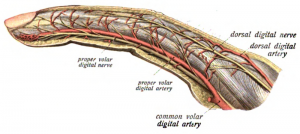.png)
Procedural Skills (SLO6)
Question 47 of 127
A 29 year old farmer presents with a crush injury to his left index finger. In order to fully assess the wound, you are planning to perform a digital nerve block. Regarding digital nerve block, which of the following statements is true?
Answer:
- Avoid using an anaesthetic with adrenaline due to risk of vasoconstriction and ischaemia.
- Each digit is innervated by four digital nerves. In order to achieve a complete anaesthetic effect, it is necessary to block all four nerves (a ring block).
- Avoid injection directly into the nerve; excessive pain or paraesthesia suggests the needle is against or in a nerve.
- Use small volumes of anaesthetic to decrease the mechanical compression on nerves and blood vessels.
- Allow 5 to 10 minutes for the local anaesthetic to work before performing the procedure.
Digital Nerve Block
Procedural Skills (SLO6)
Last Updated: 21st March 2021
Indications
Treatment and repair of many acute conditions including:
- Finger or toe lacerations
- Nail bed injuries
- Paronychias and ingrown nails
- Nail avulsions
- Foreign bodies in the digit
- Digit dislocation or fracture
Contraindications
- Compromised digital circulation
- Infection of the skin or tissues through which the needle will pass
- Allergy to the anaesthetic agent
Cautions
- Avoid using an anaesthetic with adrenaline due to risk of vasoconstriction and ischaemia.
- Consider other techniques when neurologic function of the digit has been previously compromised by an injury.
- Use small volumes of anaesthetic to decrease the mechanical compression on nerves and blood vessels.
- Limit the patient’s discomfort by using a smaller needle, injecting slowly, and using small amounts of anaesthetic.
- Avoid injection directly into the nerve; excessive pain or paraesthesia suggests the needle is against or in a nerve.
- Avoid injection into the digital blood vessels that accompany the digital nerves; aspirate before injection.
Clinical anatomy
- Each digit is innervated by four digital nerves. In order to achieve a complete anaesthetic effect, it is necessary to block all four nerves (a ring block).
- In the upper limb, the digital nerves arise from the median, ulnar and radial nerves. The two palmar digital nerves innervate the palmar aspect of the digit and the nail bed, whereas the two dorsal nerves innervate the dorsum of the digit. The two palmar nerves are accompanied by digital blood vessels as they run on both sides of the flexor tendon sheath to innervate each finger. The dorsal digital nerves run along the dorsolateral aspect of each finger.
- The digital nerves of the toes run on both sides of each toe and represent the terminal branches of the tibial and peroneal nerves.

Digital Nerves. (Image by Dr. Johannes Sobotta [Public domain], via Wikimedia Commons)
Procedure
- Place the hand or foot flat on a sterile surface.
- Clean the skin.
- Hold a syringe containing a short-acting anaesthetic, such as 1% lignocaine, perpendicular to the digit and insert the needle into the subcutaneous tissue of the digital webspace.
- After aspirating to ensure you’re not in a vessel, slowly inject 2 ml of anaesthetic into the subcutaneous tissue and infiltrate, surrounding the nerve, as you withdraw.
- Withdraw needle and repeat procedure on the opposite side of the digit.
- Allow 5 to 10 minutes for the local anaesthetic to work before performing the procedure.
Complications
- Pain at injection site
- Infection
- Bleeding
- Tendonitis from tendon injury
- Distal paraesthesia from nerve injury
- Distal infarction from vasospasm
- Inadvertent intravascular injection
- Allergic reactions
Report A Problem
Is there something wrong with this question? Let us know and we’ll fix it as soon as possible.
Loading Form...
- Biochemistry
- Blood Gases
- Haematology
| Biochemistry | Normal Value |
|---|---|
| Sodium | 135 – 145 mmol/l |
| Potassium | 3.0 – 4.5 mmol/l |
| Urea | 2.5 – 7.5 mmol/l |
| Glucose | 3.5 – 5.0 mmol/l |
| Creatinine | 35 – 135 μmol/l |
| Alanine Aminotransferase (ALT) | 5 – 35 U/l |
| Gamma-glutamyl Transferase (GGT) | < 65 U/l |
| Alkaline Phosphatase (ALP) | 30 – 135 U/l |
| Aspartate Aminotransferase (AST) | < 40 U/l |
| Total Protein | 60 – 80 g/l |
| Albumin | 35 – 50 g/l |
| Globulin | 2.4 – 3.5 g/dl |
| Amylase | < 70 U/l |
| Total Bilirubin | 3 – 17 μmol/l |
| Calcium | 2.1 – 2.5 mmol/l |
| Chloride | 95 – 105 mmol/l |
| Phosphate | 0.8 – 1.4 mmol/l |
| Haematology | Normal Value |
|---|---|
| Haemoglobin | 11.5 – 16.6 g/dl |
| White Blood Cells | 4.0 – 11.0 x 109/l |
| Platelets | 150 – 450 x 109/l |
| MCV | 80 – 96 fl |
| MCHC | 32 – 36 g/dl |
| Neutrophils | 2.0 – 7.5 x 109/l |
| Lymphocytes | 1.5 – 4.0 x 109/l |
| Monocytes | 0.3 – 1.0 x 109/l |
| Eosinophils | 0.1 – 0.5 x 109/l |
| Basophils | < 0.2 x 109/l |
| Reticulocytes | < 2% |
| Haematocrit | 0.35 – 0.49 |
| Red Cell Distribution Width | 11 – 15% |
| Blood Gases | Normal Value |
|---|---|
| pH | 7.35 – 7.45 |
| pO2 | 11 – 14 kPa |
| pCO2 | 4.5 – 6.0 kPa |
| Base Excess | -2 – +2 mmol/l |
| Bicarbonate | 24 – 30 mmol/l |
| Lactate | < 2 mmol/l |

